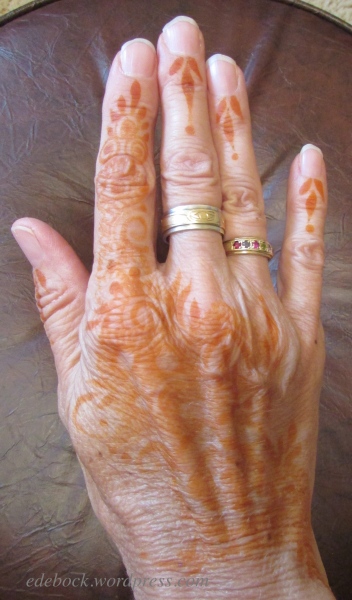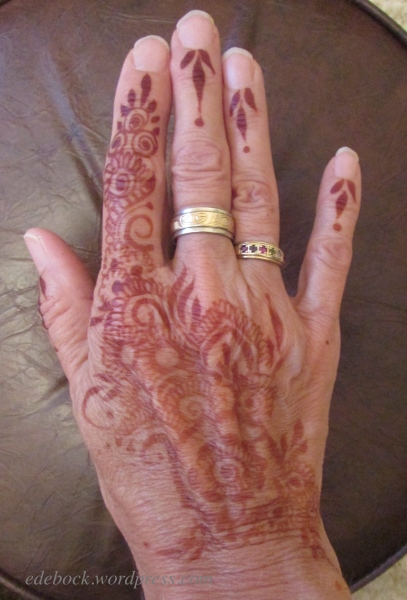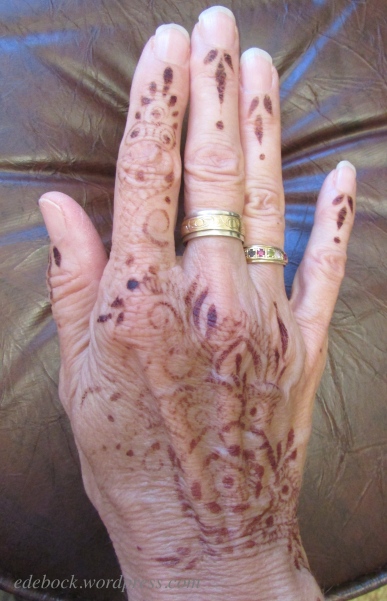 Though I have nothing against them, I’ve never had any desire to have a permanent tattoo. For quite some time, however, I’ve wanted to try the ancient art of henna and I finally had the opportunity when I came across Dinkal Patel‘s booth at a recent community event.
Though I have nothing against them, I’ve never had any desire to have a permanent tattoo. For quite some time, however, I’ve wanted to try the ancient art of henna and I finally had the opportunity when I came across Dinkal Patel‘s booth at a recent community event.
While the use of henna is most often associated with India and Pakistan, it’s origin is difficult to pinpoint. It’s earliest use appears to date back to the Pharaohs of ancient Egypt. Cleopatra, the last reigning queen of that early civilization, is said to have used it to adorn her body and beautify herself.
In modern times, until fairly recently, intricately designed henna tattoos, or mehndi, were predominantly used as part of traditional Indian wedding celebrations. Designs symbolizing good luck, wealth and health are applied to the hands and feet of the bride the night before her wedding. It is believed that the henna will cool the body’s nerve endings and help keep her calm throughout her big day. This custom holds great cultural significance in Hinduism and the symbols that are used are considered sacred.
These days, however, henna tattoos have found their way into western culture where they act as a form of body jewelry. Though Dinkal does do bridal henna, the designs that she offered at her booth were more generic. After looking at some of the examples on display, I chose to have a floral design applied to the back of my right hand. I was astonished at how quickly she applied the henna paste. Working completely freehand, she was done in no more than ten minutes and charged only $15!

Dinkal told me to leave the dried paste in place for 2 to 3 hours before removing it. I left it a little longer than that until it began to crumble and fall off. When I removed the remainder, because I didn’t know how henna dye worked, I was hugely disappointed. Most of the design was indistinct and looked like I’d simply spilled something orange on my hand or as hubby said, like I’d scraped my hand on the concrete!

Dinkal had also told me to try to keep the design dry until the next day, so even though it didn’t look like the henna was going to amount to much, I followed her instructions. That’s a little tricky to do when it’s on your right hand, but hubby took over supper making for the day and I kept it out of water. As the evening progressed, I thought perhaps it was beginning to darken, but I chalked that up to wishful thinking or an overactive imagination. Imagine my surprise and delight when I woke up the next morning and this is what I saw!

The design continued to darken until it looked like this at the end of the following day. I was delighted!

Over the next week or so, had numerous comments and compliments, even from total strangers! The most frequently asked questions were where I’d had it done and how long it would last. Though I’d read that henna tattoos can last from 1 to 4 weeks, Dinkal told me to expect about a week and a half and it appears that she was correct. Here’s how it looked at the end of day 8. Gradually disappearing, but not yet unattractive.

By yesterday morning, almost two weeks after the henna was applied, only the darkest bits remained. There was no design left on the back of my hand, just a smattering of brown dots. I did some research into how to remove faded henna tattoos and found several different suggestions. The most common ones involved baking soda and lemon juice. Another suggestion that sounded like it would be kinder to my skin involved using either baby oil or coconut oil. I didn’t have either of those on hand, so I decided to try olive oil which, like henna, has been used on skin since ancient times. It’s loaded with nutrients, is a natural humectant, and is rich in antioxidants. I applied it to the back of my hand, left it for 10 minutes, then gently scrubbed it off using a facecloth and hand soap. It worked like a charm! The designs at the ends of my fingers, though faded, still looked okay, so I left them for now.
Next time… and yes, I’m pretty sure there will be a next time… I’d like to try a henna tattoo on my shoulder or forearm. Since my hands are in and out of water constantly, I thinking that perhaps it would last a little longer in one of those locations.
The design is lovely; that it was done freehand is impressive. I’ve seen images of the henna ‘tattoos’ but never the progression (from paste through darkening). Thank you for sharing.
You’re welcome! I loved it while it lasted!
I had it done a few times in Kenya. It is sort of like a hand massage while being done so I can see it having a calming effect. The first time I saw it I wondered what was wrong with the person’s hands – LOL!!!
I think any time we allow someone to pamper us, it’s relaxing. I love going to the hairdresser for that reason.
Reblogged this on sketchuniverse and commented:
🤚🏻🖌️ HELLO SISTERS! DIDN’T YOU KNOW THIS KIND OF “JEWELRY” FOR YOUR HANDS ?
Thank you for the reblog!
Your posts deserve the best sharing. My pleasure dear 🥰